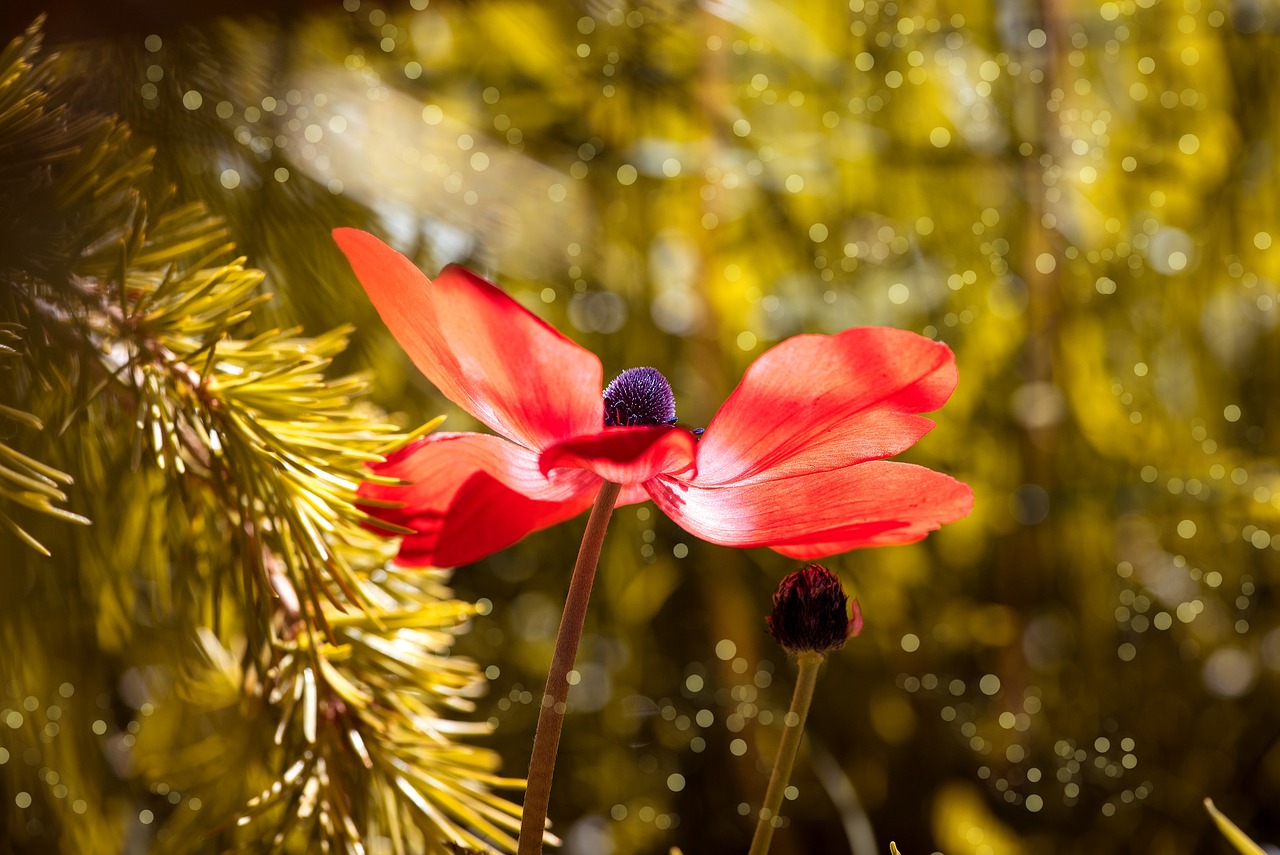The anemone flower is a stunning and versatile flower that offers more than just aesthetic beauty. It possesses a range of benefits and uses that make it a fascinating subject to explore. This article delves into the different aspects of the anemone flower, from its medicinal properties to its symbolism in art and culture.
First and foremost, the anemone flower has been used for centuries in traditional medicine for its medicinal properties. It is known for its anti-inflammatory and analgesic properties, making it effective in relieving pain and reducing swelling. Additionally, the flower has been used to treat various ailments, showcasing its versatility in the field of medicine.
Aside from its medicinal uses, the anemone flower holds significant symbolic meaning in art and culture. In different traditions and art forms, it represents a range of emotions and concepts. In some cultures, it symbolizes anticipation, fragility, and protection, while in others, it signifies rebirth, love, and luck. The anemone flower has been a source of inspiration for poets, writers, and artists throughout history, with its vibrant colors and delicate petals adding beauty and symbolism to various artworks.
Whether it’s in literature, visual arts, or cultural traditions, the anemone flower has made its mark. It has been used as a metaphor in literature to convey emotions such as beauty, transience, and vulnerability. Artists have depicted the flower in paintings, sculptures, and other art forms, capturing its elegance and vibrancy. In certain cultural traditions, the anemone flower is associated with rituals and celebrations, bringing good luck, warding off evil spirits, or symbolizing new beginnings.
Furthermore, the anemone flower is a popular choice for gardening and horticulture. Its vibrant blooms and low maintenance requirements make it an excellent addition to any garden or floral arrangement. It can thrive in various climates, adding a touch of color and elegance to outdoor spaces.
In conclusion, the anemone flower is not only a visually captivating flower but also a flower with numerous benefits and uses. Its medicinal properties, symbolism in art and culture, and popularity in gardening make it a fascinating subject to explore. By understanding the various aspects of the anemone flower, we can appreciate its beauty and significance even more.
Medicinal Properties
Anemone flower, with its stunning beauty, also possesses remarkable medicinal properties that have been recognized and utilized in traditional medicine for centuries. This delicate flower is known for its anti-inflammatory and analgesic properties, making it a valuable natural remedy for various ailments.
One of the key benefits of anemone flower is its ability to relieve pain. Whether it’s a headache, muscle ache, or joint pain, the flower’s therapeutic properties can provide much-needed relief. Additionally, anemone flower has been found to effectively reduce swelling, making it an excellent choice for treating inflammatory conditions such as arthritis.
Moreover, anemone flower is known to possess a wide range of medicinal uses. It has been used to alleviate symptoms of respiratory conditions like coughs and colds, thanks to its expectorant properties. The flower’s extracts have also been used to promote digestion and soothe gastrointestinal discomfort.
When prepared as a tea or tincture, anemone flower can be ingested or applied topically to reap its medicinal benefits. However, it is important to consult with a healthcare professional before using anemone flower for medicinal purposes, as they can provide guidance on proper dosage and potential interactions with other medications.
Symbolism in Art and Culture
Anemone flower holds symbolic meaning in different cultures and art forms. It represents anticipation, fragility, and protection in some traditions, while in others, it symbolizes rebirth, love, and luck.
In certain cultures, the anemone flower is associated with rituals and traditions. It is used in weddings, festivals, and celebrations to bring good luck, ward off evil spirits, or symbolize new beginnings. The delicate petals and vibrant colors of the anemone flower have inspired artists throughout history.
In literature, poets and writers have often used the anemone flower as a metaphor to convey emotions such as beauty, transience, and vulnerability. Its presence in literary works adds depth and meaning to the overall themes.
Furthermore, the anemone flower has been a recurring motif in visual arts. Artists have depicted it in paintings, sculptures, and other art forms, capturing its elegance and symbolic significance.
In summary, the anemone flower’s symbolism in art and culture varies across different traditions and art forms. Its representation of anticipation, fragility, protection, rebirth, love, and luck adds depth and meaning to various artistic expressions.
Anemone Flower in Literature
Throughout history, the anemone flower has captivated the hearts of poets and writers, who have skillfully used it as a metaphor to convey a range of emotions. Its delicate beauty, transience, and vulnerability make it a perfect symbol in literary works.
When poets compare a person or an object to the anemone flower, they are often highlighting its exquisite beauty. Just as the flower’s vibrant petals and graceful form can captivate the eye, so too can a person’s charm and allure. The anemone flower becomes a powerful symbol for the aesthetic qualities that bring joy and admiration.
Furthermore, the anemone flower’s short lifespan and fragile nature are often used to convey the transient nature of life itself. Just as the flower blooms for a brief period before withering away, so too do moments of happiness and youth. This metaphor serves as a reminder to cherish the present and appreciate the fleeting beauty that surrounds us.
Lastly, the anemone flower is often employed by writers to evoke a sense of vulnerability. Its delicate petals and slender stems can easily be damaged or destroyed, reflecting the fragility of human emotions and experiences. By associating characters or situations with the anemone flower, writers effectively convey the raw emotions and vulnerabilities that lie beneath the surface.
From ancient poetry to contemporary literature, the anemone flower has left an indelible mark on the world of words. Its symbolism in literature serves as a testament to the power of nature to inspire and evoke emotions in the hearts of readers. Whether it represents beauty, transience, or vulnerability, the anemone flower continues to be a recurring motif that adds depth and meaning to literary works.
Anemone Flower in Visual Arts
Artists have been captivated by the vibrant colors and delicate petals of the anemone flower, leading to its depiction in various art forms. From paintings to sculptures, the anemone flower has become a symbol of beauty and elegance in the world of art.
When artists paint or sculpt the anemone flower, they capture its intricate details and vibrant hues, bringing it to life on canvas or in three-dimensional form. The flower’s graceful petals and striking colors add depth and visual interest to the artworks, making them visually captivating.
Moreover, the anemone flower holds symbolic significance in art. It represents different emotions and concepts, such as fragility, transience, and rebirth. Artists often use the anemone flower as a metaphor to convey these ideas and evoke emotions in their audience.
Whether it’s a still life painting of a vase filled with anemone flowers or a sculpture depicting the delicate petals in motion, the anemone flower adds a touch of elegance and symbolism to the artworks. Its presence in visual arts enhances the overall aesthetic appeal and creates a deeper connection between the artist and the viewer.
Anemone Flower in Cultural Traditions
In various cultures around the world, the anemone flower holds great significance and is deeply intertwined with rituals and traditions. Its vibrant and delicate blooms are often used in weddings, festivals, and other joyous celebrations to bring good luck and symbolize new beginnings.
In some cultures, the anemone flower is believed to have the power to ward off evil spirits and protect against negative energy. It is often included in ceremonies and rituals to ensure a positive and auspicious atmosphere.
Furthermore, the anemone flower is known for its ability to convey deep emotions and sentiments. Its presence in cultural traditions adds a touch of beauty and symbolism to these special occasions.
Whether it is used as a centerpiece in a wedding bouquet, incorporated into traditional costumes, or adorned in festive decorations, the anemone flower plays a significant role in enhancing the visual appeal and symbolic meaning of these cultural events.
Overall, the anemone flower’s presence in cultural traditions highlights its universal appeal and the profound impact it has on people’s lives.
Gardening and Horticulture
Anemone flower is a popular choice for gardens due to its vibrant blooms and low maintenance requirements. Whether you have a small backyard or a spacious garden, the anemone flower can add a touch of color and elegance to any outdoor space.
One of the reasons why anemone flowers are so beloved by gardeners is their versatility. They can be grown in various climates, making them suitable for different regions around the world. Whether you live in a hot and dry climate or a cool and rainy one, you can find anemone flower varieties that will thrive in your garden.
Another advantage of growing anemone flowers is their low maintenance requirements. They are relatively easy to care for, making them a great choice for both experienced gardeners and beginners. Anemone flowers prefer well-drained soil and require regular watering, especially during dry spells. They also benefit from occasional fertilization to promote healthy growth and vibrant blooms.
When it comes to garden design, anemone flowers can be used in various ways. They can be planted in flower beds, borders, or containers, adding pops of color and texture to the landscape. Their vibrant blooms, which come in a range of colors including red, pink, purple, and white, can create stunning visual displays.
Additionally, anemone flowers can be used in floral arrangements, either fresh or dried. Their delicate petals and unique shape make them a popular choice for bouquets and centerpieces. Whether you’re planning a wedding, a special event, or simply want to bring some beauty indoors, anemone flowers can be a stunning addition to any floral arrangement.
In conclusion, anemone flower is a versatile and beautiful choice for gardens and horticulture. With their vibrant blooms, low maintenance requirements, and ability to thrive in different climates, anemone flowers can add a touch of color and elegance to any outdoor space. Whether you’re a seasoned gardener or just starting out, consider adding anemone flowers to your garden for a stunning display of nature’s beauty.
Frequently Asked Questions
- What are the medicinal properties of anemone flower?
Anemone flower has anti-inflammatory and analgesic properties. It can be used to relieve pain, reduce swelling, and treat various ailments.
- What does anemone flower symbolize in art and culture?
Anemone flower holds different symbolic meanings in various cultures and art forms. It represents anticipation, fragility, protection, rebirth, love, and luck.
- How is anemone flower portrayed in literature?
Anemone flower is often used as a metaphor in literature to convey emotions like beauty, transience, and vulnerability. It has been a recurring motif in literary works throughout history.
- How is anemone flower depicted in visual arts?
Artists are inspired by the vibrant colors and delicate petals of the anemone flower. It is depicted in paintings, sculptures, and other art forms, adding beauty and symbolism to the artworks.
- What role does anemone flower play in cultural traditions?
In some cultures, anemone flower is associated with rituals and traditions. It is used in weddings, festivals, and celebrations to bring good luck, ward off evil spirits, or symbolize new beginnings.
- Why is anemone flower popular in gardening and horticulture?
Anemone flower is a popular choice for gardens due to its vibrant blooms and low maintenance requirements. It can be grown in various climates and adds a touch of color and elegance to any garden or floral arrangement.


